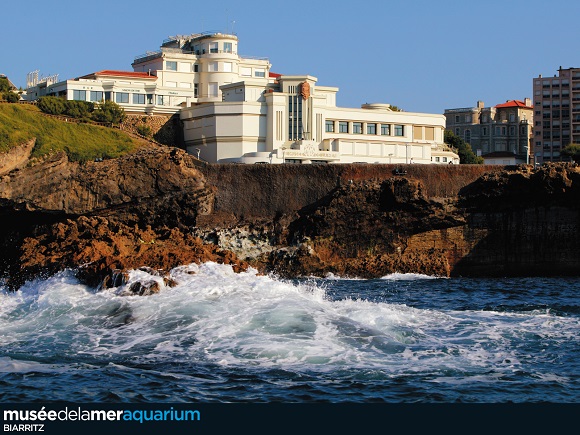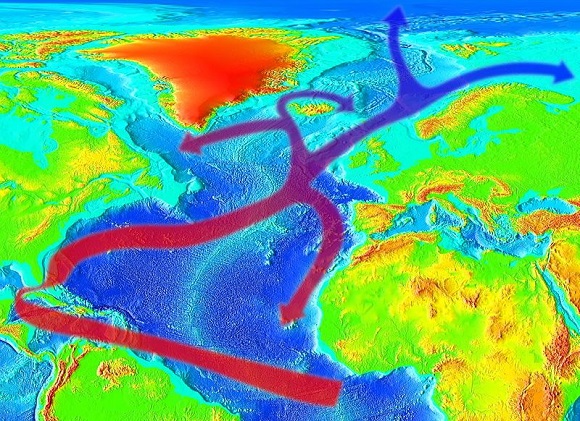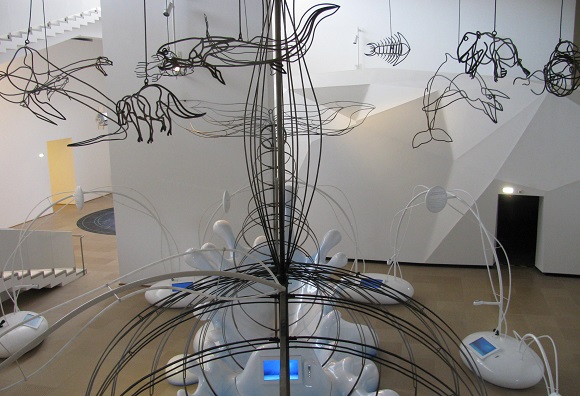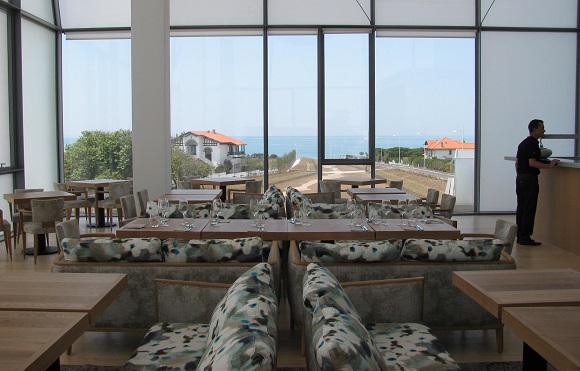
Bilbao, Spain did it. It placed itself on the map of international and financially comfortable travelers in 1997 with a single, exceptional building, its Guggenheim.
Bordeaux intends do it. Already on the map—and now increasingly so for Americans thanks to its cheery cycling PR—the city is now planning its own beacon of a museum, the Cité des Civilisations du Vin, dedicated presenting the pairing of wine with culture and with civilization, on the drawing board for 2016.
Between the two there’s Biarritz, a thick dot on the map ever since Emperor Napoleon III and Empress Eugenia began vacationing here in the 1854 (see this Biarritz Hotels article for more history). But for long-distance travelers the Biarritz brand is no longer as evocative as Bilbao or Bordeaux
In the early 1990s, I remember, Biarritz was all the rage for European-minded Americans who’d heard of the luxurious Hotel du Palais, the renovated aquarium, the particularity of Basque culture and an airport that only the best travel agents knew about. As a playground for surfing, golf and runs on the beach and as a destination for seawater therapy, Biarritz didn’t need a major museum to call attention to itself.
Well aware of the intense competition for the short attention span of those long-distance traveler (the one who counts if you want to fill your tax coffers and create a few jobs) and the absence of high-tech or research companies (the ones who count if you want the national government to take notice), the powers that be—first among them Didier Borotra, mayor since 1991—thought it was high time to rebuild the Biarritz brand. And so about a decade ago they began toying with the idea of declaring Biarritz a resort town—and why not a business-friendly town, too—with a special relationship with the ocean: think Biarritz, think ocean; think ocean think Biarritz: Biarritz Ocean, for short.
The project came to fruition with the restoration and expansion of the town’s aquarium, le Musée de la Mer (the Sea Museum), and the creation of a new museum la Cité de l’Océan (Ocean City), both inaugurated in 2011.
Musée de la Mer, the Aquarium
Biarritz now has one of France’s largest aquariums. American visitors may have seen larger, more kid-friendly aquariums, complete with live dolphin shows and high-sensation films. Despite the feeding of the seals and of the sharks, there’s less showmanship here. Nevertheless, the Sea Museum does indeed echo the town’s relationship with the Atlantic Ocean.
Facing the sea in a stylish Art Deco building of 1933 that was renovated and expanded in 2011 as part of the Biarritz Ocean project, the museum-aquarium follows the Gulf Stream in its presentation of a Caribbean lagoon, sharks, seals, rays and barracudas, while also presenting examples of life in the Indo-Pacific region.
East Coast Americans like to claim the Gulf Stream as their own, as it follows the hurricane track from the Caribbean to Maine, with a Canadian afterthought while passing by Newfoundland, after which it disappears from our maps and minds. Yet its current and climatic influence continue on the other side of the ocean where the North Atlantic’s wide river branches north toward Ireland and Scandinavia and south toward Africa.

As a grown-up destination Biarritz and the surrounding Basque Country has much to offer in terms of culture, food, sports and romance, and a fascinating cross-cultural trip could include Spanish Basque Country (Bilbao et al.). Yet the town and its surrounding also offer a nice backdrop for family fun, and the aquarium is a part of that.
Cité de l’Ocean
Another part of that is the Cité de l’Océan, the major project of Biarritz’s reinforced relationship with the ocean.
The building, designed by the American architect Steven Holl in collaboration with the Brazilan Solange Fabiao, takes the form of a simple wave unfurling toward the beach, with life visible under the swell, i.e. underground. It’s an easy metaphor though not exciting architecture.
Unfortunately, the wave building sinks unobtrusively in the landscape 500 yards from the beach and a long mile from the center of town, so it takes some effort getting to and from. An argument can be made for taking a healthy walk along the beach to get there, but it’s an argument that few will buy into, opting instead for one’s rental car, a taxi or the regular bus service from the aquarium. As a vote for the bus route, combining the aquarium with the Cité de l’Océan is the most direct way to get into the spirit of Biarritz Ocean.
Through interactive exhibits in French, Spanish and English, 3D films and daily activities, the Cité de l’Océan informs about various aspects of the oceans and our relationship with it: origins, tides, waves, myths and legends associated with the ocean, the evolution of life-forms (with the whale as the prime example) and the weather (visitors “ride” a boat through a storm).
Early on in the town’s reflections on a new museum a decade ago there were voices in favor of devoting it to surfing, then to incorporating surfing as a secondary aspect. But by the time it opened surfing appeared as minor afterthought, with only a small portion devoted to the sport, which is something of a shame given Biarritz’s history with surfing, not to mention my own surfing lesson (as told here).

The museum largely targets a family audience with children 7 to 13 years old, though older children and adults have much to learn here. It’s a natural complement to a visit to the aquarium, which can appeal to all ages. At the Cité de l’Océan I found myself interested though not impressed, entertained by not enthralled. A more sensational interactivity would help, but it is indeed informative if you pay attention. They have managed to keep the museum from being “chiantifique,” loosely meaning boring science, but haven’t quite made a thrilling museum either inside or out. Nevertheless, presenting the high stakes of climate change, biodiversity, over-fishing, the effect of a heavily populated coastline, the need to creating drinking water by desalinization and the acidification of the ocean was never going to be as sexy as a photogenic piece of contemporary art à la Bilbao or a museum explaining how Europe owes its existence to wine à la Bordeaux.
The museum is far from being an international calling card. Though most of its eggs are currently in the tourism basket, Biarritz (population 30,000 and home to 10,000 secondary residences) still aspires to attract research and production companies involved with the ocean. This has yet to materialize. Whether Biarritz can indeed develop its brand association with the ocean remains to be seen.
Nevertheless, Biarritz’s attempts to getting mileage from its historical relationship with the ocean are not far-fetched; though less evocative than Bordeaux’s relationship with wine, it has more historical basis than Bilbao did with contemporary art two decades ago. There’s still room for the project to develop.
Meanwhile, the Cité de l’Océan does have a nice enough restaurant, Le Sin, in its favor.

For the international traveler, these museums remain are secondary to the overall attraction of Biarritz. The town’s major assets are its exceptional site and all it has to offer in terms of sports, spas, a daily food market and the weather. You don’t need museums to enjoy that, but it’s nice to know they’re there in case you’ve brought along the kids or in case it rains.
© 2013, Gary Lee Kraut
Biarritz Océan is the umbrella title for the Musée de la Mer Aquarium and the Cité de l’Océan. The museums are open daily except Mondays November to March (open Mondays of French school vacations during those months). Closed the three middle weeks of January. Joint tickets are available for the two museums. The Cité de l’Océan is free for children under 6; the aquarium is free for children under 4.
For more on Biarritz on France Revisited read: Biarritz: The Surfing Lesson and Biarritz Hotels.
Official site of the Biarritz Tourist Office: http://tourisme.biarritz.fr/en
Getting to Biarritz: There are direct flights to Biarritz from Paris and other French cities as well as from various northern European capitals (London, Dublin, Copenhagen, Brussels, Rotterdam, Stockholm). By train, Biarritz is 5:20 from Paris and 2:00 from Bordeaux.


